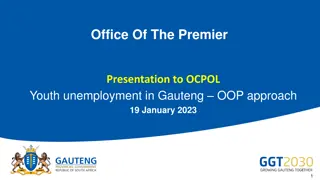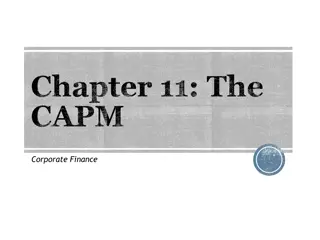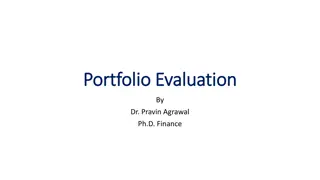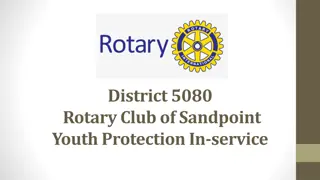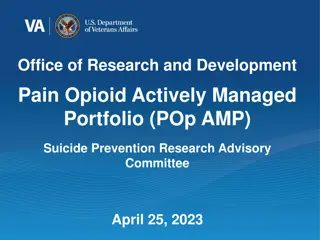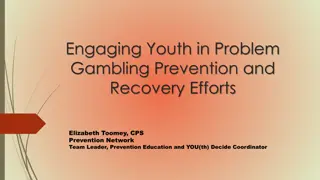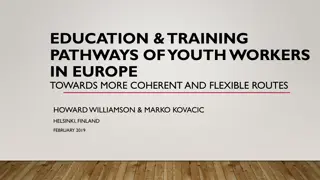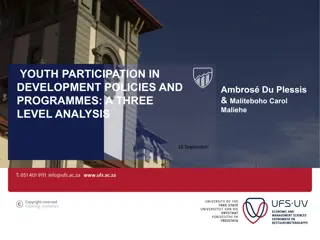National Youth Policy 2030 Presentation to the Portfolio Committee
The National Youth Policy 2030 presentation provides an update on the approved policy, focusing on the youthful population in South Africa and the importance of youth development. The policy aims to address past injustices and current challenges, empowering young people to drive positive change. Past achievements, such as increased school enrollment and youth-owned businesses, highlight the impact of previous policies. The new 10-year policy aligns with national and global strategies, emphasizing collaboration for youth development.
Download Presentation

Please find below an Image/Link to download the presentation.
The content on the website is provided AS IS for your information and personal use only. It may not be sold, licensed, or shared on other websites without obtaining consent from the author. Download presentation by click this link. If you encounter any issues during the download, it is possible that the publisher has removed the file from their server.
E N D
Presentation Transcript
National Youth Policy 2030 Presentation to the Portfolio Committee on Women, Youth and Persons with Disabilities 11 November 2020 SECRET 1
1. PURPOSE The purpose of the presentation is to update the Portfolio Committee on the approved National Youth Policy (NYP) 2030, including the process followed. SECRET 2
2. BACKGROUND South Africa is a home for a youthful population. Young people aged between 18-34 constituted nearly a third of South Africa s population (17.84 million) in 2019. One (1) in four (4) persons will be between the ages of 15-29, between now and 2030. Investing in policy development ensures the protection of human rights and social justice for the youth who are denied access to essential services in order to build a more resilient society especially where youth development takes centre stage. In was in this context that the 1st and 2nd National Youth Policies (NYP) were developed and approved by Cabinet to respond to youths needs, for the periods 2008-2014; and 2015-2020. The period for the NYP 2015-2020 is coming to an end in 2020, hence the NYP was reviewed to provide an opportunity for the country to assess the broader agenda in relation to youth. SECRET 3
3. INTRODUCTION In developing this youth policy, the DWYPD partnered with UNFPA. Unlike previous youth policies, the new youth policy will be for 10 years. The 10 year period is in line with the National Development Plan (NDP) and the UN Strategy 2030. Cabinet approved the NYP 2020/30 on 21 October 2020. The NYP 2030 is a cross-sectoral policy aimed at effecting change for the youth at local, provincial and national levels. It redresses the wrongs and injustices of the past, whilst simultaneously addressing persistent, new and emerging challenges of the country s diverse youth. The policy proposes interventions that enable positive development for young people as individuals and as members of families, communities and the South African society. It centrally places the youth as key players in their own development and in advancing development of their communities, the nation, the continent and globally by outlining tangible actions, commitments, resourcing, and accountability by all stakeholders working together and in partnership with the youth. SECRET 4
4. PAST ACHIEVEMENTS Some of the important achievements attained through the NYP include, but are not limited to: Almost double enrollment in schools which, with an increase in the number of learners with post-school qualifications from 1.7 million to 3.6 million; increase in the number of youth owned businesses from 595 000 in 2015 to 641 000 in 2016 as well as financial and technical support to youth start-ups and enterprises; increased investments in tertiary education, largely benefitting youth from poor households; the use of ICTs in educational institutions for the advancement of the youth; Improved youth participation in public employment programmes; several interventions aimed at improving the health and well-being of youth, such as Prevention of and Treatment for Substance Abuse Act 70 of 2008, National Drug Master Plan 2013 2017, National Adolescent and Youth Health Policy 2016-2020, B WISE Mobisite, launched in 2017 etc. approval of the National Youth Service Framework; and establishment of institutions dedicated to render youth development services. SECRET 5
5. PROBLEM STATEMENT Endemic, structural unemployment (59.0% for 15-24 in Q1 2020) Low Entrepreneurship levels Low levels of education Poor transition to work High Transport and data costs. Lack of ICT infrastructure and poor connectivity. Poor Education Outcomes School dropout rates increased from Grade 9 upwards, reaching almost 12% in both Grades 10 & 11. Low skills mismatch Low transition from school and work Unacceptably high suicide rates (13.4 per 100 000 in 2019). High Risk and Vulnerability factors among the young include: Risky and unhealthy lifestyles Youth crime Mental illness (esp. depression) Gender Based Violence & Femicide Poor sexual and reproductive health disproportionate HIV prevalence rates among 18-24 year old females Covid 19 impact Lack of social cohesion and unity, manifesting in racism, inequality, homophobia, tribalism and other forms of discrimination. Many youth migrate from their provinces in search of better socio- economic opportunities. Unrecognized youth work; resulting in high turnover and unskilled workers; inadequately resourced interventions; fragmented service delivery; limited impact SECRET 6
6. VISION AND OBJECTIVES VISION an integrated, holistic and sustainable youth development, conscious of historical imbalances, current realities, and diversities in building capacities for young people, so that they can in turn contribute to building a better life for all. MISSION & GOAL Goal: To enhance the capabilities of young people, so that they are responsible and contributing members of their communities and society. Mission: Promote positive youth development outcomes in addressing the needs of young people Facilitate young people s smooth transition into independe -nce Strengthen youth development institutions in delivering coordinated packages of services Collaborate with young people in building a better South Africa, Africa and a better world Integrate youth development into the mainstream of government s policies, programmes, and the national budget. Inculcate and strengthen a culture of patriotism among young people Accelerate young people s access to quality social, political, and economic opportunities Improve coherence and reach of youth development service providers 7
7. NYP 2020 NYP2030 NDP2030 The NYP aims to deal with the root causes of young people s vulnerability in South Africa NYP 2020 Economic transformation and Participation. Education, Skills development and 2nd chances Health Care and Combatting Substance Abuse Nation Building & Social Cohesion Effective and Responsive Youth Development Machinery responsive youth development machinery SECRET NYP 2030 Quality Education, Skills development & 2nd chances Economic transformation, Entrepreneurship & Job creation Physical and Mental Health promotion including COVID 19 Social Cohesion & Nation Building Effective and NDP 2030 Economic Transformation, & job creation Education, Skills Development & Health Social Cohesion & Safe Communities Capable and Ethical State 8
8. POLICY PROPOSALS The policy identifies policy priorities with key interventions aimed at improving the prospects of youth towards positive holistic youth development. ECONOMIC TRANSFROMATION, ENTERPRENEURSHIP & JOB CREATION Implement the Presidential Youth Employment Initiative and Economic Reconstruction and Recovery Plan Introduce Basic Universal Income Grant for Unemployed Youth Implement set-asides for youth across sectors Implement improved public employment schemes Involve youth in land reform, rural development and agriculture value chain Support township and rural economies Develop and support youth-owned businesses and cooperatives (Spurring Entrepreneurship) QUALITY EDUCATION, SKILLS AND SECOND CHANCES Ensure universal access to quality ECD Develop teachers and review curriculum Implement inter-disciplinary early intervention programmes Provide second chances to facilitate completion and re- engagement with educational institutions Provide ongoing career guidance for technical, technology-based and productive economic sectors Increase opportunities for quality post-school skills training for all PHYSICAL AND MENTAL HEALTH PROMOTION Support healthy lifestyles through physical and mental health promotion Promote mental health amongst the youth Combat substance abuse among youth Combat gender-based violence and femicide Promote sexual and reproductive health and rights Mitigate against the impact of pandemics FOURTH INDUSTRIAL REVOLUTION 9
9. POLICY PROPOSALS Cont SOCIAL COHESION AND NATION BUILDING Entrench social cohesion and nation building through multi-pronged approach Adequately resource and scale up the National Youth Service Expose youth to positive constitutional values that promote South African identity Support the youth in confronting systemic racism within society. Foster leadership and active citizenry amongst the youth Expand and adequately resource compulsory school and community sports Utilise the 4th Industrial Revolution in fostering Social Cohesion, and Nation building EFFECTIVE AND RESPONSIVE YOUTH DEVELOPMENT MACHINERY Strengthen Youth Machineries to ensure effectiveness and responsiveness Coordinate service delivery for high impact service provision Facilitate recognition of youth development practice as a profession FOURTH INDUSTRIAL REVOLUTION 10
10. PROCESS FOLLOWED The Minister established a multi-sectoral Technical Reference Team (TRT), consisting of the following organisations: Government: DWYPD (Coordinator and Secretariat); National Youth Development Agency (NYDA); National Treasury; Basic Education; Higher Education, Science and Technology; Trade, Industry and Competition; DPSA; and COGTA. Civil society partners including the South African Youth Council; Institutions of Higher Learning (UNISA; UNIVEN; UCT (SALDRU); Business bodies (BBC; BUSA). SECRET 11
11. 11. CONSULTATIONS SUMMARY The NYP 2030 was broadly consulted with relevant stakeholders physically and virtually, for ten (10) months. It was gazetted for public inputs/ comments. The initial deadline for comments was 16 March 2020 and it there was six weeks extension for public inputs/ comments to 28 April 2020, with advertisements placed in Newspapers. Another extension was granted from 01 August to 30 September 2020 at the request of the Portfolio Committee. Face to face consultations were held in all provinces. Inputs were received from political formations, NGO s, government entities and youth. Other stakeholders were reached through social media such as WhatsApp, Twitter and Facebook. Two webinars were held on 29 June and 18 September 2020. An invitation was extended to the Portfolio Committee for attendance of the latter webinar. There were opinion pieces of the NYP 2030 in Newspapers as well as interviews on numerous Radio and TV stations, including a pre-recorded message broadcasted in all Radio stations. SECRET 12
12. CONSULTATIONS SUMMARY cont A draft NYP 2030 was circulated electronically and presented twice to the 3 clusters namely: (i) Economic Sectors, Investment, Employment and Infrastructure Development (ESIEID); (ii) Social Protection, Community and Human Development (SPCHD); and (iii) Governance, State Capacity and Institutional Development (GSCID). A Socio-Economic Impact Assessment (SEAIS) was also conducted by the SEIAS unit in the Presidency, and a certificate for approval was issued. SECRET 13
13. SUMMARY OF INPUTS AND COMMENTS RECEIVED Sample of Comments individual Organisation/ Summary of comments What was done/ Way forward Provincial Inputs from physical consultations Western Cape 4IR should not be seen as a separate pillar but must be mainstreamed across the policy. 4IR is a cross-cutting pillar across the policy. KwaZulu Natal Bring back physical education in schools (curriculum School and community sports, that is adequately resourced, included in the policy SECRET 14
14. INPUTS AND COMMENTS RECEIVED Sample of Comments Organisation/ individual Summary of comments What was done/ Way forward Written inputs in response to gazette Youth Capital, Youth Lab, Activate, Dr Shakira Choonara, Equal Education, FemConnect, The Psychological Society of South Africa (PsySSA) Student Division, and The Youth Voice of SA. High quality education in schools; The need for implementation, monitoring and evaluation of the policy; anti-racism; Clear about corruption; youth parliaments; clearer exit strategy for young people in internships and public employment The comments were largely integrated into the NYP. Some programmatic interventions have been packaged for inclusion in the Integrated Youth Development Strategy and the M&E Framework. SECRET 15
15. INPUTS AND COMMENTS RECEIVED Sample of Comments Written inputs received during first extension Organisation/ individual National Youth Development Agency Summary of comments What was done/ Way forward The Presidential Youth Employment Initiative and ECD were included in the draft; however the policy was kept at 5 pillars for focus, and as many other stakeholders who preferred that the pillars remain at five. Inclusion of the Presidential Youth Employment Initiative and ECD in the policy; Basic education Higher education and skills development Health and wellbeing Youth in the labour market Youth entrepreneurship Active citizenry, social cohesion and youth service Effective and efficient government, responsive to the needs of young people. SECRET 16
16. INPUTS AND COMMENTS RECEIVED Sample of Comments Organisation/ individual Summary of comments What was done/ Way forward Inputs from Departments National Treasury Definition of 4IR is provided on p.9 under Section 4 and it its elements are included under relevant sections. The National Treasury s comments address various issues and concerns including inadequate/inaccurate analysis of some of the noted challenges, mandate overlaps, proposed new structures that address youth issues in government entities, absence of costing and time schedules for proposals, funding implications of proposals that make new demands on the fiscus and 4IR. The comments further also refer to ineffectiveness of M&E processes in DSAC and suggest interventions in the DoEL and DSD. Linking career guidance and support with the Presidential Youth Employment Initiative include and adding ESSA and the Public Employment Services at the DoEL as resources for identifying unemployed youth inclluded. Addressing issues of low completion rates among students from poor households who enroll in TVET colleges. The issue of youth focal points has been included because it emerged from public consultations as one of the approaches used to collect information for the NYP review. SECRET 17
17. INPUTS AND COMMENTS RECEIVED Sample of Comments Inputs from Clusters and Cabinet Committee Organisation/ individual SPCHD, GSCID, ESEID, and ESEID Cabinet Committee Summary of comments What was done/ Way forward DSBD, ARDLR; and CDT were consulted with the latter providing written inputs; Strategic thrust of the NYP 2030 highlighted as acceleration and scaling up implementation of interventions; Include the Economic Recovery plan and Mass Employment of young people included; The department is in the process of amending the NYDA Act to ensure effective implementation of the NYP Consult the DSBD, ARDLR; and CDT; Specify the strategic thrust of the NYP 2030; Include the Economic Recovery plan and Mass Employment of young people; Amend the NYDA Act to ensure effective implementation of the NYP SECRET 18
Cabinet has approved the final draft National Youth Policy (NYP) 2020-2030 for implementation by all sectors of society. DWYPD is developing an M&E framework with high level indicators to track the NYP implementation, within 4 months of the NYP s approval. The NYDA will develop an Integrated Youth Development Strategy to give effect to implementation of the NYP within 4 months of the NYP s approval. DWYPD will monitor development of an Integrated Youth Development Strategy by the NYDA, its finalization, and facilitate approval by Cabinet. There will be continuous monitoring, evaluation, and reporting of the NYP 2030 to ensure accountability to stakeholders and young people as service beneficiaries. The NYP 2030 will be launched in 2021 and is being popularized amongst stakeholders and the youth. Sector policies and strategies to be aligned to the NYP 19








